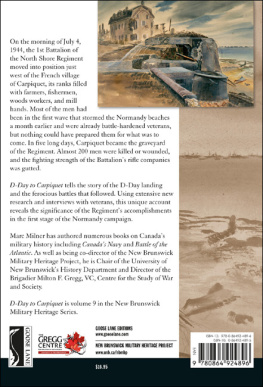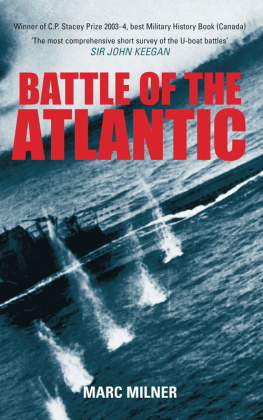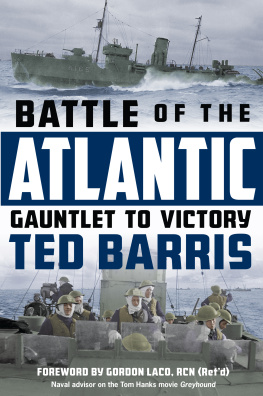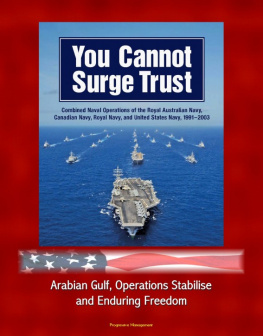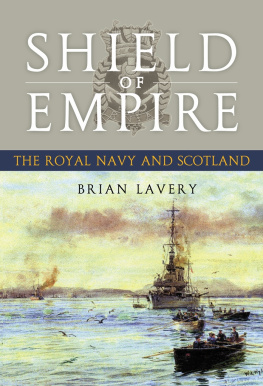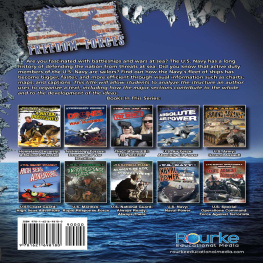CANADAS NAVY: THE FIRST CENTURY
Second Edition
From its eighteenth-century roots in exploration and trade, to the major conflicts of the First and Second World Wars, through to current roles in multinational operations with United Nations and NATO forces, Canadas navy now celebrating its one hundredth anniversary has been an expression of Canadian nationhood and a catalyst in the complex process of national unity.
In the second edition of Canadas Navy, Marc Milner brings his classic work up to date and looks back at one hundred years of the navy in Canada. With supplementary photographs, updated sources, a new preface and epilogue, and an additional chapter on the navys global reach from 1991 to 2010, this edition carries Canadian naval history into the twenty-first century. Milner brings effortless prose and exacting detail to discussions about topics as diverse as Arctic sovereignty, fishing wars, and international piracy. Comprehensive and accessible, Canadas Navy will continue to provoke discussion about the past and future of the countrys naval forces and their evolving role in the interwoven issues of maritime politics and economics, defence and strategy, and national and foreign policy.
MARC MILNER is a professor in the Department of History and Director of the Gregg Centre for the Study of War and Society at the University of New Brunswick.
CANADAS NAVY: THE FIRST CENTURY
Second Edition
Marc Milner

University of Toronto Press 2010
Toronto Buffalo London
www.utppublishing.com
Printed in the U.S.A.
First edition published 1999; reprinted 2000
Second edition published 2010; reprinted 2011, 2012
ISBN 978-0-8020-9604-3

Printed on acid-free paper.
Library and Archives Canada Cataloguing in Publication
Milner, Marc
Canadas navy : the first century / Marc Milner. 2nd ed.
Includes bibliographical references and index.
ISBN 978-0-8020-9604-3
1. Canada History, Naval. 2. Canada. Royal Canadian Navy History. 3. Canada. Canadian Armed Forces. Maritime Command History. I. Title.
FC231.M54 2010 359.00971 C2009-906562-2
University of Toronto Press acknowledges the financial assistance to its publishing program of the Canada Council for the Arts and the Ontario Arts Council.

University of Toronto Press acknowledges the financial support of the Government of Canada for its book publishing activities through the Canada Book Fund.
To W.A.B. Alec Douglas sailor, scholar, gentleman, friend
Governments cannot live forever, for governments are born to grow and die as well as men ... but mark my words, whoever may take over the reins of power will have to have a navy, as every nation with a seashore must have and has had in the past.
SIR WILFRID LAURIER
10 NOVEMBER 1910
CONTENTS
PREFACE TO THE SECOND EDITION
When Canadas Navy: The First Century appeared in 1999 the world was an uncertain place. The end of the Cold War had stripped away much of the focus of Canadian defence planning. So, too, did the clamour for a peace dividend following nearly fifty years of armed stand-off between east and west. To be sure, the world remained troubled and, paradoxically in a time when the defence budget was slashed by some 30 per cent, the Canadian forces were remarkably active. Bosnia, Kosovo, East Timor, the Persian Gulf, Somalia, Rwanda, the Congo, Haiti, and many smaller missions all demanded people, equipment, and money. In the last decade of the 20th century the solution to many of these troubles seemed to be light, mobile forces designed to maintain stability while the international community acted to restore order in failed states around the world. Indeed, by the end of the 1990s the Canadian army was re-organizing itself to be easily deployable at home and abroad, and the navy was planning to build the ships to carry them.
The navy, for its part, was in the throes of a major renaissance in the 1990s. During that decade virtually the entire combat fleet was renewed: twelve Canadian Patrol Frigates fresh from the builders, four submarines purchased from the British, a dozen new coastal defence vessels entering service, and the four remaining Tribal class destroyers completely rebuilt and modernized. Only the fleet support ships and the aging Sea King helicopters had been missed by the modernization process although in the case of the helos, not for want of trying. Never before, not even in halcyon days of the early 1960s when the new St Laurent class dominated the fleet, was the capability of the navy so well aligned with what was required of it. On the eve of the 21st century the navy was the most modern and capable of Canadas armed forces.
That new navy was fully tested in the decade that followed. In some respects, the Al-Qaeda attacks on the United States on 11 September 2001 simply confirmed trends already in evidence in the postCold War world: the problem of failed states and disaffected peoples. But the attacks also ushered in a totally new era, what US President George Bush described as the global war on terror. The Canadian Forces were careful never to describe the new instability as a war, but there was no disguising the fact that the threat after 9/11 was profoundly different from that of the 1990s. Al-Qaeda combined disaffection and instability with religious fundamentalism, a virulent dislike of the west, opposition to globalization, and, for want of a better word, modernity, and fuelled their beliefs with huge amounts of petro dollars. They also gave disaffection and the new world disorder a global reach. Whereas the 1990s was all about resolving problems locally and regionally, the post-9/11 world is all about containment abroad and security at home. The decision in the fall of 2001 to remove the Taliban government in Afghanistan, and eliminate that country as a base for Al-Qaeda operations, was coupled with an increased level of operations in defence of Canada in Canada. In short, fighting chaos and extremism in central Asia also meant focusing on defence and security at home in new and very challenging ways.
The Canadian navy was in good shape materially at least in 2001 to meet these disparate demands. The naval renaissance begun in the late 1970s in response to NATO requirements produced a modern, highly professional service by the late 1990s. Moreover, the navy had, through a number of means, developed expertise that made it invaluable to the international community, including a reach that spanned the globe. Although, like the other services, the navy had been hollowed-out in the Chretien years, it retained an ability to surge highly capable forces for short periods and to deploy individual ships a world away almost indefinitely. And so on the eve of its centennial, the navy found itself busier than ever before: chasing pirates and guarding food shipments for hungry people off the east coast of Africa, policing the fisheries and the Canadian economic zones on both coasts, patrolling the Arctic, bringing aid to Haiti and the victims of hurricane Katrina, and cruising the azure blue waters of the south Pacific trying to keep up with the rapidly changing technology of the new imperial fleet, the USN. In 1910 Sir Wilfrid Laurier imagined a small fleet of 5,000 ton Canadian cruisers helping to police the oceans of the world, securing Canadian interest abroad, and all the while looking after Canadas interests closer to home. A century later his dream has been fulfilled.
Next page


